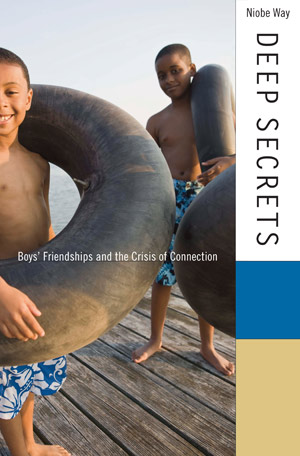
My longitudinal research with hundreds of boys over the past twenty years has indicated that boys’ friendships, particularly during early and middle adolescence, are deeply intimate. They sound more like out of Love Story than Lord of the Flies.
White, Black, Latino, Chinese-American, and Chinese boys openly express their love for their friends. In in-depth interviews that I am my research team conducted, boys emphasized that sharing “deep” secrets was the most important aspect of their closest male friendships. They also told us that they would go “wacko” without these friends.
During late adolescence, however, boys begin to lose their closest male friendships, become more distrustful of their male peers, and in some cases, become less willing to be emotionally expressive. They start sounding, in other words, like gender stereotypes.
When late adolescent boys talk about the intimacy that might remain in their closest male friendships, they use the expression “no homo” to underscore their heterosexual status. Questions about close friendships from the interviewers become, for the boys during late adolescence, questions about sexuality.
For example, when Augustus (the fictional name for one boy quoted in the book) is asked in his freshman year of high school whether he has close male friendships, he describes the emotionally intimate friendships he has with a particular boy in his school. When he is asked about his closest friendships in his senior year of high school, he simply says: “I’m not gay.” He also proceeds to describe how he feels lonely at times because he does not have any close friendships any longer.
Many of the boys we studied in late adolescence spoke about feelings of loneliness and isolation and how they missed their formerly close male friendships. We discovered these patterns of loss and distrust right at the developmental moment when the rate of suicide among boys in the United States becomes four times that of girls.
”Many of the boys we studied in late adolescence spoke about feelings of loneliness and isolation and how they missed their formerly close male friendships. We discovered these patterns of loss and distrust right at the developmental moment when the rate of suicide among boys in the United States becomes four times that of girls.”
Why have we, as a culture, ignored the intimacy in boys’ friendships for so long, despite the fact that research has revealed such intimacy among boys over the past century?
And why do boys lose their friendships as they grow older?
The reason appears to be that patterns and expressions of intimacy among boys are considered by our culture as girlish and gay. In other words, to admit that boys have or want emotionally intimate male friendships, or to reveal their emotional sensitivity, is to implicitly accuse them of being gay.
Rather than questioning why emotional sensitivity and emotionally intimate friendships are given, in our culture, sex (female) and sexuality (gay) connotations, we simply ignore boys’ friendships and the ways in which they do not fit our gender stereotypes.
And that appears to be the reason why boys lose their close friendships during late adolescence: cultural pressures to becoming men are intensified during this period of growth.
In American culture, becoming a man is linked with being emotionally stoic, autonomous, and physically tough. If boys do not follow these dictates of manhood, they are perceived as gay or girlish. Boys, particularly those who are heterosexual, don’t want to be perceived in such ways.
These changes also occur because boys, like girls, increasingly buy into the cultural belief that having a romantic partner makes you mature and happy and that romantic relationships are more important than friendships. They begin to believe, like many adults, that friendships should be sacrificed for the sake of romantic relationships.
Yet this belief system is relatively new. In the 19th century United States, couples took their best friends on their honeymoons. We now live in a culture where that would never happen. Today friendships are considered competition in a romantic partnership—not what may foster intimacy and the health and wellbeing of those involved in the friendships.
Research consistently reveals that friendships are key to all aspects of wellbeing. So we should be alarmed by the findings of loss of friendships and increased feelings of distrust among boys during late adolescence.
Close friendships provide a sense of self-worth, validation, and connectedness to the larger world and significantly enhance psychological, physical, and academic wellbeing. Adolescents without close friendships are at risk of depression, suicide, dropping out, disengagement from school, early pregnancy, drug use, and gang membership.
Research has even suggested that the effects of the quality of friendships on adjustment may be stronger for boys than for girls.
Among adult men and women, research also indicates that those who have close friendships or strong social support networks are less prone to depression and more likely to thrive in all areas of their lives.
In a six-year study of 736 middle-aged men reported in the Journal of Psychosomatic Medicine, Kristina Orth-Gomer and her colleagues found that attachment to a single person did not appear to lower the risk of heart attack and fatal coronary heart disease—whereas having close friendships did. Smoking was the only risk factor comparable in strength to lack of friendship support!
Health researchers find that people with strong friendships are less likely than other to get colds and common illnesses and that people with fewer friends are at higher risk of death. In their book The Spirit Level, epidemiologists Kate Pickett and Richard Wilkinson conclude that the two most important factors that determine the health and wellbeing of people living in developed nations are social status and friendship. Study after study has underscored the importance of close friendships throughout the lifespan.
In addition, recent scholarship in neuroscience, developmental psychology, psychiatry, and evolutionary anthropology are emphasizing the empathic and cooperative nature of all humans—not just girls and women.
We should be alarmed at the findings that boys do not consistently think or behave in gender stereotypic ways. Unlike their stereotypes, they are emotionally astute, deeply empathic, and yearning for emotionally intimate friendships.
Why is this cause for alarm? Because much of the way we think about parenting and schooling boys are based on gender stereotypes. Even the most recent school reforms are based on gender stereotypes (e.g., creating “boy curriculums”).
Boys are deeply emotional, social, and in need of close relationships. So we need to rethink how we parent boys. And school should rethink what to do to foster boys’ development.
On the other hand, we should also be relieved to discover that boys and men are human too.
”Maturity should be defined as ability to have mutually supportive, intimate, and deeply empathic relationships.”
More generally, we need to rethink how we are defining maturity, what are goals are for our children, and how we are raising and schooling our children.
Maturity in this culture is equated with independence, autonomy, and separating from others.
Given the research underscoring the necessity for all humans of having social and emotional skills and close relationships, maturity should be defined as ability to have mutually supportive, intimate, and deeply empathic relationships. If that was the epitome of maturity, the way we think about parenting and about schooling our children would radically change.
In addition, if we paid attention to the decades of research underscoring the importance of friendships for the wellbeing of males and females, we would also change the way we parent and school our children. Rather than autonomy, independence, or critical thinking, the goals of development would be to foster children’s social, emotional, and cognitive capacities so that they can thrive in all areas of their lives.


Niobe Way is Professor of Applied Psychology at New York University, Director of the NYU Developmental Psychology Program, and Co-Director of the NYU Center for Research on Culture, Development, and Education. She is also the President for the Society for Research on Adolescence. Niobe Way received her doctorate from Harvard and was a postdoctoral fellow at Yale. Her research has been funded by the National Institute of Mental Health, The National Science Foundation, The William T. Grant Foundation, The Spencer Foundation, and other foundations. Besides Deep Secrets, featured in her Rorotoko interview, Way is the author of numerous books, including Everyday Courage: The Lives and Stories of Urban Teenagers.